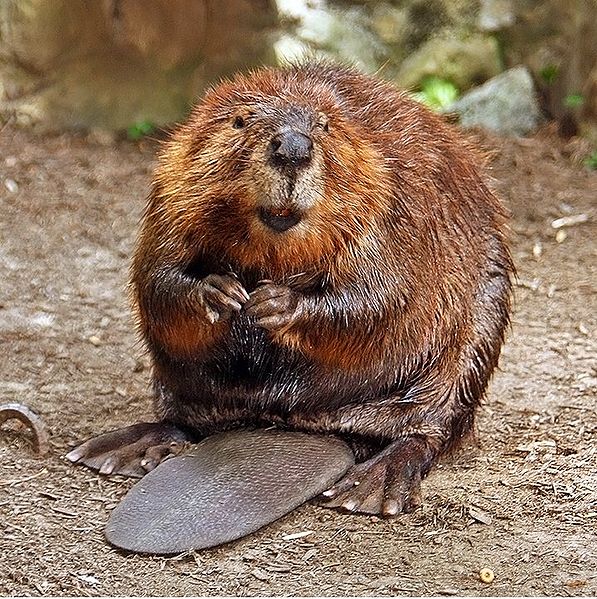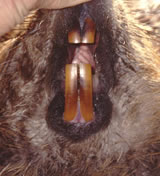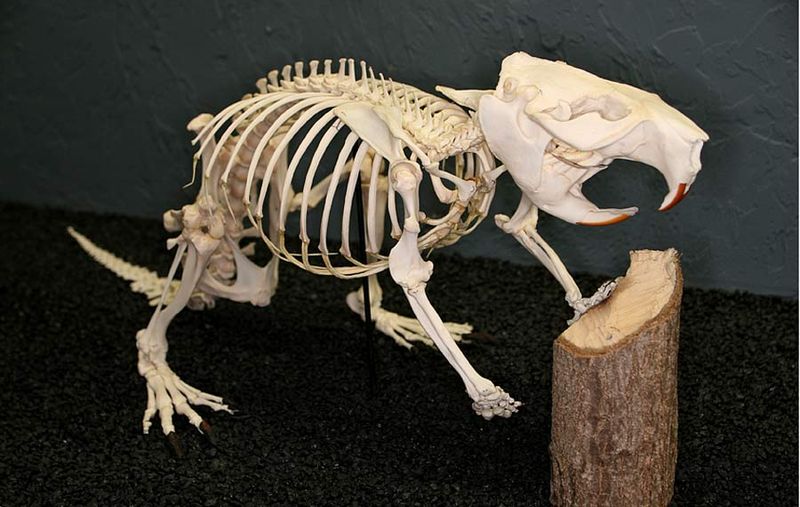
Adaptation
Beavers have become very well adapted to the
environments they inhabit. They work extremely hard making dams, building dens,
finding food and so on. They have many body structures that help
them to accomplish these things. They normally walk on all
four feet but are able to walk on their hind legs when they have to
carry things which are held under their chins for stability.
 They
waddle when they walk on their hind legs and have a very awkward run
so they are unable to move quickly on land. They have much stronger
hind legs as they are used to support a lot of weight. They have
five toes on their feet which are webbed for swimming. They have a
smooth black leathery layer covering their palms. Their feet
are full of nerves that can easily sense vibrations in the ground
that could possibly be those of a predator. Their feet also act as
paddles in the water and propel them large distances. They make
swimming look like it takes no effort at all. They have a
drop-shaped body. When they swim, they lay on their backs and only
the nostrils, eyes and ears can be seen above the water. Beaver fur
plays a very important role in protection. They have a thick layer
of fur that is shorter and close to the skin (two to three cm long),
along with longer coarse hairs on top (five to six cm long). The
claws on their feet are used to brush the coat and keep its coat from
getting tangled and matted. The second toe located on the back foot
has a claw that is designed especially for combing. The fur keeps
the beaver not only warm, but also dry. The coat doesn’t allow
water to get through to the skin because it has oil covering the
top. The oil comes out of glands located right where the tail is
attached to the beaver’s body. The fur not only helps the beaver to
float, but it also shields them from claws and teeth of predators.
The fur molts once every summer to keep the coat in key condition.
They
waddle when they walk on their hind legs and have a very awkward run
so they are unable to move quickly on land. They have much stronger
hind legs as they are used to support a lot of weight. They have
five toes on their feet which are webbed for swimming. They have a
smooth black leathery layer covering their palms. Their feet
are full of nerves that can easily sense vibrations in the ground
that could possibly be those of a predator. Their feet also act as
paddles in the water and propel them large distances. They make
swimming look like it takes no effort at all. They have a
drop-shaped body. When they swim, they lay on their backs and only
the nostrils, eyes and ears can be seen above the water. Beaver fur
plays a very important role in protection. They have a thick layer
of fur that is shorter and close to the skin (two to three cm long),
along with longer coarse hairs on top (five to six cm long). The
claws on their feet are used to brush the coat and keep its coat from
getting tangled and matted. The second toe located on the back foot
has a claw that is designed especially for combing. The fur keeps
the beaver not only warm, but also dry. The coat doesn’t allow
water to get through to the skin because it has oil covering the
top. The oil comes out of glands located right where the tail is
attached to the beaver’s body. The fur not only helps the beaver to
float, but it also shields them from claws and teeth of predators.
The fur molts once every summer to keep the coat in key condition.

Moving on to the tail, the tail is wide and is the shape of a canoe paddle. The tail is attached to the body with a huge muscle that has hair covering it. As for the tail, it is black and shiny and has a scaly texture. The tail has many purposes, one of which is providing support when the beaver walks on two legs. It also helps the beaver steer in the water, as the tail can move in all directions. The tail is even used for protection by putting it up in the air and slapping it down into the water. The tail slap is a way to interact with other beavers by warning them that there is something suspicious and they should quickly move to the den or somewhere safe. If they think that there is something suspicious going on, they stand on their hind legs and turn their head and sniff to the side. They also point their ears to see if they can tell where any strange sounds are coming from. Their ears have fur covering them completely and are very small and round. They have valves located inside their ears which close when the beaver is underwater so that water doesn’t get in and cause infection. The nose is also very well-developed as they can detect where water and trees are located at great distances. The nose also has valves which close and open back up when they come back to the water surface. The valves continue to allow beavers to smell underwater. One of the only senses that are not as well-developed is their sight. They are still able to see considerably well underwater and they are near-sighted. They have a nictitating membrane covering their eyes to protect them from debris and other things in the water. Beavers also have large lungs and livers which accumulate oxygen-rich blood. This allows beavers to a quarter of a mile or up to fifteen minutes before coming back up from underwater.

Beavers have very well adapted teeth. They have two incisors on their upper jaw and two on the lower jaw. The upper set overlaps the lower ones. Their teeth are an orange color and they have a very hard layer of enamel covering them. Soft dentine covers the back of the tooth. They also have sixteen molars, four on each side on the top and bottom. Because the teeth or used constantly for cutting down trees, they get worn down easily, which is why the teeth continue to grow throughout the beavers life. The teeth are even used to push large objects. Their mouths are well adapted for chewing underwater. They can close their lips behind their teeth so that they can chew without water flooding into their lungs.
Finally, they have a very large and thick skull because of the strong muscles for chewing.
